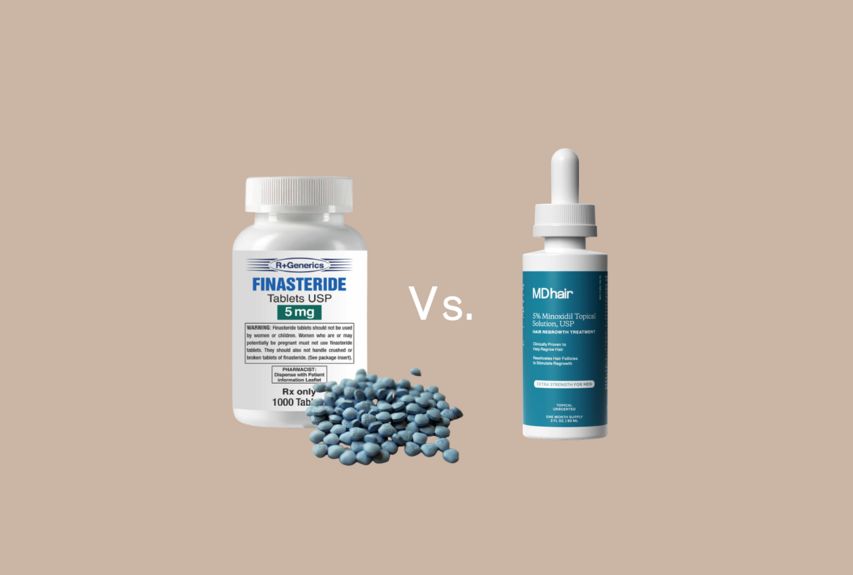Minoxidil vs. Finasteride: a head-to-head comparison

If you're experiencing hair loss, you may have heard of two medications called minoxidil and finasteride, commonly used to treat the condition. While both drugs can effectively promote hair growth, they work in different ways and are used differently. Here's a comparison of minoxidil and finasteride to help you decide which one may be right for you.
Minoxidil:
- Topical minoxidil is applied to the scalp. It can be used over the counter or without a prescription by both men and women.
- How it works: Minoxidil stimulates hair growth by increasing blood flow to the hair follicles.
- Use: Minoxidil is usually applied to the scalp twice a day. It comes in a liquid or foam form and should be applied to the affected areas of the scalp.
- Results: It may take several months to see results from minoxidil. In clinical studies, minoxidil is effective in promoting hair growth in both men and women. However, results may vary, and it's essential to be patient and consistent to see the best results.
- Side effects: Possible side effects of minoxidil include scalp irritation, dryness, and redness. These side effects are usually mild and go away on their own.
Finasteride:
- Finasteride is an oral medication that is taken by mouth. It is only approved for use in men and is available by prescription only.
- How it works: Finasteride inhibits the production of the hormone DHT, which is believed to contribute to male pattern baldness. By preventing hair loss, finasteride stimulates hair growth.
- Use: Finasteride is usually taken once a day, with or without food. It comes in a pill form and should be taken as directed by a healthcare professional.
- Results: It may take several months to see results from finasteride. In clinical studies, finasteride has been shown to be effective in promoting hair growth in men. However, results may vary, and it's essential to be patient and consistent to see the best results.
- Side effects: Finasteride may cause decreased sex drive, impotence, and breast tenderness or enlargement. These side effects are rare and usually go away on their own. However, it is essential to report any unusual symptoms to a healthcare professional.
Comparison of Minoxidil and Finasteride
| Feature | Minoxidil | Finasteride |
|---|---|---|
| Form | Topical (liquid or foam) | Oral tablet |
| Prescription Needed | No (available over the counter) | Yes (prescription only) |
| Approved For | Men and Women | Men only |
| How It Works | Increases blood flow to hair follicles | Inhibits DHT production to prevent hair loss |
| Frequency of Use | Applied twice daily | Taken once daily |
| Time to See Results | Several months | Several months |
| Common Side Effects | Scalp irritation, dryness, redness | Decreased libido, impotence, breast tenderness (rare) |
| Requires Medical Supervision | No | Yes |
| Mechanism | Stimulates hair growth directly | Prevents further hair loss and indirectly promotes growth |
It's important to note that finasteride is a prescription medication and should only be used under the guidance of a healthcare professional. It may not be suitable for everyone, and discussing the potential risks and benefits with a doctor before starting treatment is essential.
In conclusion, minoxidil and finasteride are two medications that can be effective in treating hair loss. Both men and women can use minoxidil as a topical medication applied to the scalp. Oral finasteride is approved for use only in men and inhibits DHT production.
Shop:
MInoxdil 5% for men
Minoxdil 2% for women
More info:
References:
- Olsen EA, Weiner MS, Delong ER, Pinnell SR. Topical minoxidil in early male pattern baldness. J Am Acad Dermatol. 1985;13(2 Pt 1):185-192.
- Kaufman KD, Olsen EA, Whiting D, et al. Finasteride in the treatment of men with androgenetic alopecia. J Am Acad Dermatol. 1998;39(4 Pt 1):578-589.
- Shanshanwal SJ, Dhurat RS. Superiority of combined therapy with microneedling and minoxidil 5% versus minoxidil 5% alone in androgenetic alopecia: A randomized comparative evaluator-blinded study. Int J Trichology. 2017;9(1):14-18.
- Suchonwanit P, Iamsumang W, Rojhirunsakool S. Efficacy of topical combination of 0.25% finasteride and 3% minoxidil versus 3% minoxidil solution in female pattern hair loss: A randomized, double-blind, controlled study. Am J Clin Dermatol. 2019;20(1):147-153.
- Gubelin Harcha W, Barboza Martínez J, Tsai TF, et al. A randomized, placebo- and active-controlled, double-blind study of the efficacy and safety of dutasteride 0.5 mg once daily in men with male pattern hair loss. J Am Acad Dermatol. 2014;70(3):489-498.e3.
- Ramos PM, Sinclair R, Kasprzak M, et al. Minoxidil 1 mg oral versus minoxidil 5% topical solution for the treatment of female-pattern hair loss: A randomized clinical trial. J Am Acad Dermatol. 2020;82(1):252-253.
- Jha AK, Udayan UK, Roy PK. Comparative study of efficacy and safety of oral finasteride and topical minoxidil in male androgenetic alopecia. J Clin Diagn Res. 2015;9(8):WC01-WC03.
- Olsen EA, Dunlap FE, Funicella T, et al. A randomized clinical trial of 5% topical minoxidil versus 2% topical minoxidil and placebo in the treatment of androgenetic alopecia in men. J Am Acad Dermatol. 2002;47(3):377-385.
- Tsuboi R, Itami S, Inui S, et al. A randomized, placebo-controlled trial of 5% topical minoxidil solution in the treatment of male pattern baldness in Japanese patients. Eur J Dermatol. 2009;19(5):691-696.
- Gupta AK, Charrette A. The efficacy and safety of 5α-reductase inhibitors in androgenetic alopecia: A network meta-analysis and benefit-risk assessment of finasteride and dutasteride. J Dermatolog Treat. 2014;25(2):156-161.
Find the most effective hair growth products for you by taking the free hair assessment.



